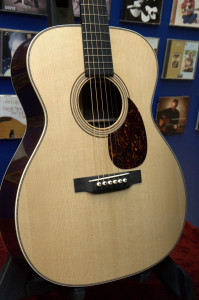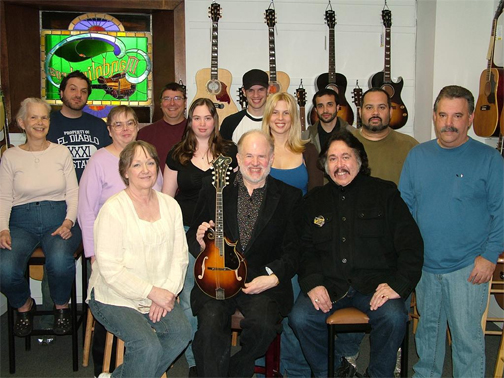The new Martins slated for the Winter NAMM show are out of the bag.
One Man’s Guitar will offer exclusive video on January 22, the day the NAMM show opens its doors. Written reviews to follow in the coming days.
Vintage Tone Right Out of the Box
In addition, Martin has gone public with their new Vintage Tone System (VTS) that is featured on most of the new models. Martin’s VTS is a proprietary technique that employs the torrefication of spruce soundboards and bracing to artificially “age” the wood, with positive results in tone production and in the wood’s resistance to fluctuation in environmental humidity. To learn more about torrefaction and its use in modern luthiery, go HERE.
See the excellent video below, released today by Martin, explaining how their new technique differs from all previous forms of torrefaction used at the factory and by other guitarmakers. But first…
A Quick Rundown of the New Martins
000-15 Burst
The only “basic” model among the new Martins is the smaller sibling to the D-15M Burst already on the market. These 15 Series guitars offer exceptional value, with all-solid wood construction including South American mahogany for the back, sides, top and neck, and an Indian rosewood fingerboard and bridge.
Of all Martins made without a traditional, hand-fitted dovetail neck joint, these are my favorites. Mahogany tops have their own special musicality, with a certain sweetness to the highs and special kind of presence in the lows.
And now that the 15s are made with the recently introduced “simplified dovetail” joint they sound even better. What makes this model new and different is the shaded top – something Martin only recently started using on mahogany.
Dreadnought Junior
The other modestly priced guitar among the new Martins has a shape like a dreadnought, but in a smaller size. They are cool too look at and to play. This is being targeted as a travel guitar, but also one ideal for children or those who simply prefer smaller guitars.
This is made out of sapele along with other features of less-expensive Martins. But since this is being listed under the “Junior series” it is hoped we will see other versions.
The original R&D version of the Dreadnought Junior was made exactly like the Standard Series dreadnoughts, with the traditional dovetail neck joint, all solid woods, gloss finish, etc. It was sensational. I’d buy one in a heartbeat.
But I was told it would likely never make it into production that way. Hopefully this more economical version will sell well enough, and eventually we will see full blown Style 18 or 28 versions someday.
These are different than the old 7-28 reduced size dreadnought from the late 1970s, as they tweaked the junior’s shape so it is not exactly the same dimensions as a full-size dread only smaller. Those guitars were fun and novel, but over built and didn’t really sing.
The full gloss prototype I played sounded wonderful. It is a very successful design in terms of feel and comfort and sound volume. I am sure the more-affordable sapele version will also sound good and likely sell well.
D-35 Brazilian 50th Anniversary
Martin introduced the D-35 in the mid-1960s. The first Martin with a three-piece back, it was conceived to take advantage of nicely figured Brazilian rosewood that was too small to use on a two-piece back.
They also introduced 1/4″ non-scalloped bracing on a dreadnought, in an early attempt to replicate the vintage Martin resonance and tone. Instead, they invented a new type of Martin resonance and tone with a rich, round bottom end and pinpoint clarity in the top trebles.
This commemoration model has Madagascar rosewood for the sides and back, with a Brazilian rosewood center wedge. It also has “Certified European spruce” on top, which is Martin’s way of saying it is European spruce, but the Swiss dealer who sold it to them was unable to specify the actual country where it was harvested.
Other special D-35s made with Alpine spruce tops have all been realllllly great. This one also comes with the modern neck shape and string spacing sometimes called the High Performance neck with Performing Artist taper.
CEO – 8
Following in the footsteps of the smash hit CEO-7, the latest model designed by C.F. Martin IV is another tribute to a classic Gibson model, the SJ-200. A prototype has been seen at some public events already, so the gossip mill of Martin copying Gibson designs is well underway.
While this new guitar looks obviously similar to a Gibson SJ-200 with a sunburst top, it is very much a unique musical instrument, and I look forward to getting to know its personality better next week.
Instead of creating a new body shape, this is a Martin Grand Jumbo, their largest size, with some very interesting features.
It sports solid sycamore for the back, sides and neck. Last year’s D-18 Sycamore is an open and airy guitar that has a leaner, more defined bass than typical Martin dreadnoughts. The extra-large sound chamber on the CEO-8 should increase bass response, without overdoing things.
It also has a top of torrefied Sitka spruce, given Martin’s new VTS treatment, and a non-scalloped 5/16” X-braces with “graduated scalloped tone bars,” a bracing configuration seen on a Martin for the first time. AND it has the D-TAR Wave-length multi source pickup system, basically the same thing that Laurence Juber uses on all his stage guitars, like his Martin OMC-44K LJ.
OM-28 Authentic 1931 and OM-45 De Luxe Authentic 1930
The most anticipated of new Martins in memory has finally arrived. Closely based on a 1931 OM-28, but with Madagascar rosewood for the back and sides rather than the ultra rare and expensive Brazilian rosewood, this new 28 should be every bit as impressive as previous Authentic Series offerings, if not more so thanks to the new VTS treatment, which offers a top and bracing artificially aged so that it is structurally similar to spruce found on real pre-war Martins.
I am sure there is so much anticipation involved with this model that it will never live up to the hopes and dreams of certain people – at least one person I know of gave a down payment for one several months before any public announcement was made that it would be appearing in 2015.
But I have every expectation that it will be one seriously great OM. Once examples get out among the shops and general population, it will be fun seeing how it stacks up side by side with some of those small-shop luthier replicas that have been appearing for the past 40 years. The new VST treatment should give it a head start when it comes to opening up and breaking in.
But where the OM-28A will sell in large numbers, the OM-45DXA is limited to 11 instruments at an astronomical price, even if it is a 3rd the cost of the real thing, if you could even find one for sale. Made only in 1930, it is considerably rarer than the more famous pre-war D-45.
This new 45 does have Brazilian rosewood, along with the VTS Adirondack spruce top and bracing. Only the elephant ivory nut and saddle is missing from the original, due to its worldwide ban, and to Martin’s commitment to environmentally sound practices. But frankly, I think good old bone sounds so much like ivory, even more than partially fossilized ivory, that it matters not.
I have played 3 of the existing prewar OM-45DX models. Each is different from the almost-as-rare OM-45 made between 1930 and 1933 by virtue of a pickguard inlaid with a flower arrangement made of abalone shell, and ornate banjo tuners that stick out the back of the headstock, although at least one had the tuners replaced with side tuners. One of the three was owned by the late cowboy crooner Roy Rodgers and among of the most excellent acoustic guitars I have ever played. The one used to create this new Authentic series instrument may be even better.
I played these two masterpieces 5 years apart, so I cannot compare them with any fairness. Both qualify as the kind of guitar that one could sit alone with for hours, perfectly enraptured. It is too bad the replicas are so limited and so expensive.
My only other lament about these new OMs is the fact I played both of the vintage Martins used to create them and, frankly, the neck on the 1930 OM-45 DX is THE most wonderful OM neck I have ever had in my hands, and it is being reproduced on only 11 Authentics.
I lobbied from the heart for it to be put on the OM-28A. As far as I am concerned Martin should retool their entire line to put a replica of this neck, down to smallest detail, on every OM they produce from now until the unmaking of the world. It is that wonderful, comfortable, and effortless to play.
But the decision was made to stay with the convention of creating an Authentic series model based on one specific vintage Martin. So the world will be denied that wonderful neck, except for the 11 very lucky and very wealthy individuals who buy the new Authentic version of the 45.
Not that the 28 neck is a bad OM neck. But it has more of a pup tent V to it and is what I consider a typical prewar OM-28 neck – less bulky than the late 1933 version and not as pointy as some others – rather than than the exceptional perfection that appeared on certain OMs made in 1930, like the 45 here mentioned.
Read more about Martin’s Authentic series HERE.
CS-00041-15
The Custom Shop series provides another winner for 2015 in a guitar I am anticipating more than any CS model since the first CS-21-11. The CS models offer unique aesthetic features in combination with woods and special touches like hide glue and ultra-responsive light construction, at a cost considerably less than what a private customer would be charged by the Custom Shop if the exact same guitar had been built as a one-off custom order.
This guitar is a 000 made with 1/4″ bracing and a short-scale version of the High Performance neck, that has the modified low oval profile in combination with the Performing Artist taper and string spacing. It also has figured cocobolo for the back and sides, wood fiber inlays, including a lovely intertwined ribbon marquetry on the back made from East Indian rosewood and South American mahogany, and figured koa binding and accents.
Reviews of other CS Models can be found HERE.
The rest of the new Martins are all limited editions. There is a cocobolo version of the fancy Purple Martin bird theme already seen in a koa version. The D-41 Purple Martin K sounded magnificent and full-bodied, so this darker rosewood version will likely be more of a powerful beast in tone and dynamics than the pretty songbird motif suggests.
And then there are two NAMM Show Specials, available only to dealers who come to the Martin booth during the show.
The SSC-OM35-15 is made exclusively for Canadian dealers and features a cherry wood body with a maple center wedge on the back, herringbone trim around the Adirondack spruce top and sound hole, and Style 42 snowflakes on the ebony fingerboard.
The SS-GP42-15 is the NAMM Show Special available world wide but limited to fifty guitars max. This is the second Martin limited edition to feature the Grand Performance body size without the usual cutaway on the treble side. Last year’s CS-GP-14 was lightly-built and geared toward nuanced fingerstyle playing. This Show Special is fancier and made from stunning woods, festooned with intricate inlays, and like the GP-14 it has cutting edge Fishman Aura VT electronics.
Read the official Martin Press Release of all the models HERE
Learn more about Martin’s Vintage Tone System treatment and watch the official VTS video in the post below this one.
Like this:
Like Loading...


